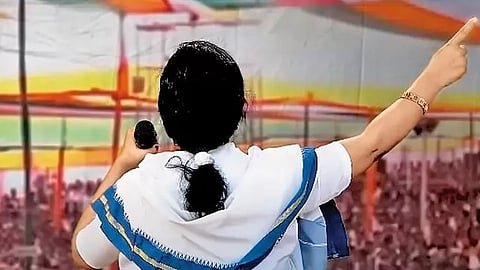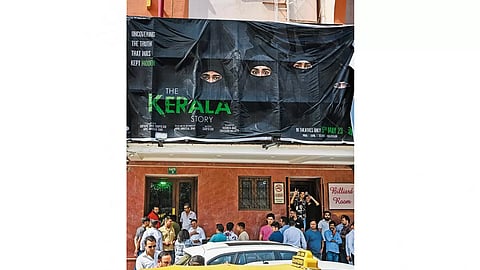When filmmaker Vivek Agnihotri—often referred to as the ‘poster-boy’ of the newly-emerged genre of ‘Hindutva propaganda films’—announced in April 2022 that his next venture would be a film named The Delhi Files, speculation was rife that it would be about the 1984 anti-Sikh riots in Delhi. Agnihotri never confirmed the plot, until recently. It turns out that the film is about the Partition, set in West Bengal, and focussing on the role that ‘Delhi’ played in the bifurcation of Bengal in 1947.
Brainwash Factory: Films And Hindutva Narrative
At least three films on West Bengal that present the Hindutva narrative are set to release before the 2026 assembly elections
With this, he is expected to complete his ‘files trilogy’—the two previous ones being the 2019 feature, The Tashkent Files, a movie version of the Hindutva conspiracy theory around the death of former Prime Minister Lal Bahadur Shastri and the 2022 release The Kashmir Files, a film on the Hindu exodus from the valley that helped him attain the pinnacle of fame and commercial success.
“We haven’t even finished writing the script, but many people are already calling it names. This includes Bengal Chief Minister Mamata Banerjee, to whom I recently sent a legal notice. It’s a very important film for India and I don’t want it to get diluted because of the communal politics of myopic politicians,” Agnihotri tells Outlook. Though set in West Bengal in the context of the Partition, it’s named The Delhi Files because, according to a Twitter comment by the director, “the seeds of pain and suffering of the Bengal Partition were all sowed in Delhi”.

“You’ll understand the relevance of the title only when you see the film,” says Agnihotri, and jokingly adds, “Delhi is the heart of India and an unhealthy heart is responsible for other diseases.” According to him, not many people know the truth about the Partition, as it is mostly the Partition of Punjab that has found portrayal in popular literature, education and movies, whereas it was Bengal where the Partition actually took a deadly shape. The research started in March 2022 and the team is currently working on the script and pre-production. It is expected to be released sometime in late 2024.
The representation of the Partition in movies and literature outside Bengal has, indeed, largely remained limited to the portrayal of Punjab’s bifurcation. In West Bengal, however, there is no dearth of literature and cinema dealing with the Partition. It was one of the most-recurrent themes in the iconic Ritwik Ghatak films. However, none of the critically acclaimed work dealing with the Partition attempts to sensationalise the event.
The Delhi Files “delves deep” into the subject and “probes how even now the same communal politics has kept India in constant conflict,” and seeks answers to questions such as “who was responsible then and who is responsible now”, says the writer-filmmaker.
It should not be surprising then if these remarks by Agnihotri prompt one to speculate that the film would blame the Congress for the Partition and the distress it caused to the Bengali Hindus. It would likely contrast it with the role of the BJP’s ideological founder, Syama Prasad Mookerjee, in securing West Bengal’s place in India, and would point fingers at the Mamata Banerjee-led Trinamool Congress (TMC) for endangering the Hindus for the sake of ‘vote bank politics’. If such a plot turns out to be true, it would be a copybook screen adaptation of the BJP’s Bengal textbook.
But Agnihotri’s film isn’t going to be the sole representative of this genre set in West Bengal. After all, the state assembly elections are due in 2026, when the BJP, currently the main opposition party, is expected to go all-out to win a state that has remained at the top of their priority list for years due to its “strategic importance”, but has remained elusive when it comes to popular votes.
In a state where Muslims made up 27 per cent of the population, according to the census of 2011, the BJP and other Hindutva organisations are regularly warning that it would soon turn into something like the Muslim-majority Bangladesh, where Hindus are routinely persecuted.
The trailer of a film titled The Diary of West Bengal was released on April 8, rather quietly, weeks before the impending release of the film The Kerala Story ahead of the Karnataka state elections that created a nationwide controversy on charges of manipulating facts to suit an anti-Muslim agenda. “Around the world, the rule of governments chosen by the people has been called democracy, but the other aspect of this (democracy) is that if the majority is formed by Muslims, Sharia will be the law,” says the voiceover at the beginning of the two-minute trailer of The Diary of West Bengal.
It drew public attention in mid-May, after the Kolkata Police issued summons to its director, Sanoj Mishra. The police asked the Mumbai-based director to appear before them to answer some questions, but he has chosen not to, and has reportedly taken legal opinion, while publicly expressing his fear that he might never return alive if he visits Kolkata.

On the face of it, the opening sentence of the trailer is factually incorrect. According to the United States Commission on International Religious Freedom (USCIRF), of the 46 countries in the world where Muslims form the majority of the population, 23 declare Islam to be the state religion in their constitutions. The rest either proclaim the state to be secular or make no pronouncement concerning an official religion.
Nevertheless, against the backdrop of poorly executed and edited shots, coupled with amateurish acting, the narrator continues: “In West Bengal, to facilitate ‘the other aspect of democracy’, organised Rohingya and Bangladeshi extremists are being settled with governmental assistance.” For the “unorganised Hindus”, West Bengal has become “the second Kashmir.” “Mamata’s love for Rohingya Muslims is forcing Hindus to leave their homes,” a character is shown as saying. He is later seen in a saffron-clad avatar, proclaiming that West Bengal had turned even worse than Kashmir.
Every word that the narrator uses comes from the BJP’s Bengal textbook—dialogues repeated by BJP leaders of all ranks. A woman clad in a white saree with a blue border—a dress code chief minister Mamata Banerjee is associated with—is heard saying things that Banerjee is known to have said, for example, never allowing the National Register of Citizens (NRC) to be implemented in the state.
Curiously, the film is produced by Waseem Rizvi Films. The man behind this Muslim name is neither a Muslim nor known by this name anymore. Waseem Rizvi, the former head of the Uttar Pradesh Shia Wakf board, converted to Hinduism in December 2021—incidentally on the anniversary of the Babri Masjid demolition, and assumed the new name of Jitendra Narayan Singh. He had earlier written and produced a film Ram Ki Janmabhoomi, which too was directed by Sanoj Mishra.
The trailer of The Diary of West Bengal proudly claims at the beginning that every event and fact presented in the trailer and the film is based on real events, that the film does not intend to hurt any race, religion, or community, and that the film’s intention is to create public awareness.
The claim of everything being based on facts is questionable, though. Take for example the claim of government support in helping Rohingya or Bangladeshi migrants settle in West Bengal or the one about “Hindu exodus”. At least 1,177 Rohingya immigrants were arrested/detained or rescued from trafficking by police in different states between 2017 and 2021, reported a paper titled India: the Status of Refugees—2021, published by the Rights and Risks Analysis Group, a New Delhi-based independent think-tank. Of them, the highest number was from West Bengal—386, followed by 187 in Jammu and Kashmir; 141 in Telangana; 123 in Tripura; and, 98 each in Delhi and Assam. Of the 386 arrests in West Bengal, 253 were nabbed by the Border Security Force (BSF) while crossing the international border with Bangladesh, while 33 were arrested by the state police from different parts of the state.
“The police in West Bengal cannot be said to have been any softer on illegal immigrants than the police in other states. They keep arresting Bangladeshi nationals and have also arrested Rohingya families holding cards issued by the United Nations High Commissioner for Refugees (UNHCR),” says human rights activist Kirity Roy, who heads the West Bengal-based NGO, Manabadhikar Suraksha Mancha (MASUM). “We believe the West Bengal government is pursuing the same policy as the Union government when it comes to illegal migrants,” says Roy.
There is at least one other film in the planning stage. Being initiated by actor-turned-BJP leader Rudranil Ghosh, the convenor of the Bengal BJP’s cultural cell, it too will deal with the Partition, but would focus on the specific incident of the Muslim League’s call for Direct Action Day on August 16, 1946—aimed to ensure Kolkata became part of East Pakistan—that eventually led to the horrific riot popularly known as the Great Calcutta Killings.
It appears that the film’s mission is to highlight the role of Gopal Mukhopadhyay, better known as Gopal Pantha for the pantha or goat meat shop that he owned. He played a key role on behalf of the Hindus during the August 1946 riots. He is an icon that the Hindutva groups have been trying to popularise over the past few years, referring to him as “Hindu Veer (hero)”. “We’ll announce the details, including the producer, director, or the title, in a while. At present, we are in the research stage. We hope to start shooting by November. If things go as per plan, it should be released in 2024 or 2025,” says Ghosh.
He says that the film was necessitated by the fact that incidents like the Great Calcutta Killings by pro-Pakistan elements and ‘the heroic role of the likes of Mukhopadhyay who was a saviour of Kolkata’s Hindus’, had been calculatedly buried under the carpet by those who ruled the state during different times—the Congress, the Left and the TMC. “The public needs to know how pro-Pakistan people massacred Bengali Hindus; tried to take away Kolkata; and, those who saved West Bengal’s Hindus. Those who wanted people to forget these were complicit in one way or the other,” says Ghosh.